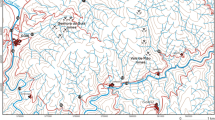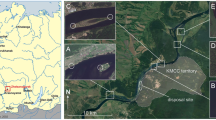Abstract
In Portugal, the industrial production of phosphate fertilizers, has been dealing with a specific raw material—north African phosphate rock—with a high content of trace metals and natural radioactive elements mainly from the 238U decay series. A disabled phosphate plant located in the vicinity of the river Tejo estuary has produced phosphoric acid for several decades (1950–1989) and dumped tons of phosphogypsum (PG) on retention lagoons, formerly decanted and deposited into a stockpile. This paper deals with the assessment of radionuclides, rare earth elements (REEs) and heavy metals transfer to plants (fam. Plantaginaceae, Plantago sp.) and mosses (fam. Bryaceae, Bryum sp.) growing naturally on the PG pile. In Plantago sp., the concentration ratio (CR, plant tissue/PG) was 0.187 for 226Ra and 0.293 for 210Pb. The translocation factor (TF, aerial parts/roots) was 0.781 for 226Ra and 0.361 for 210Pb. In contradiction to the high CR, the leachability of 226Ra from PG was low, lower than 2%. The results confirmed the role of mosses as biomonitors. A high quantity of contaminants collected in its biomass confirmed the hypothesis of their significant transport by air and rain water. High concentrations of heavy metals (As, Cd, Zn, W) in samples collected on the stockpile are an evidence of their transport from former industrial zones in the surroundings and present even more important risk for public health and environment than natural radionuclides and REEs from the PG stockpile.


Similar content being viewed by others
References
Abril, J. M., García-Tenorio, R., Enamorado, S. M., Hurtado, M. D., Andreu, L., & Delgado, A. (2008). The cumulative effect of three decades of phosphogypsum amendments in reclaimed marsh soils from SW Spain: 226Ra, 238U and cd contents in soils and tomato fruit. Science of the Total Environment, 403, 80–88. doi:10.1016/j.scitotenv.2008.05.013.
Borges, R. C., Ferreira, A. A., de Souza, W. F. L., & Bernedo, A. V. B. (2017). The geochemistry of natural of natural radionuclides in saline soils from Brazil treated with phosphogypsum Imbituba. Water, air and Soil Pollution, 228(2), 1–11. doi:10.1007/s11270-016-3235-y.
Borylo, A., Nowicki, W., & Skwarzec, B. (2013). The concentration of trace metals in selected cultivated and meadow plants collected from the vicinity of a phosphogypsum stack in northern Poland. Polish Journal of Environmental Studies, 22, 347–356.
Brown, D. H. (1984). Uptake of mineral elements and their use in pollution monitoring. In A. F. Dyer & J. G. Duckett (Eds.), The experimental biology of bryophytes (pp. 229–256). New York, London: Academic Press.
Brown, D. H., & Bates, J. W. (1990). Bryophytes and nutrient cycling. Botanical Journal of the Linnean Society, 104(1–3), 129–147. doi:10.1111/j.1095-8339.1990.tb02215.x.
Calabrese, S., & D’Alessandro, W. (2015). Characterization of the Etna volcanic emissions through an active biomonitoring technique (moss-bags): part 2—morphological and mineralogical features. Chemosphere, 119, 1456–1464.
Carvalho, F. P. (1995). 210Pb and 210Po in sediments and suspended matter in the Tagus estuary, Portugal. Local enhancement of natural levels by wastes from phosphate ore processing industry. Science of the Total Environment, 159, 201–214.
Cotte-Krief, M. H., Guieu, C., Thomas, A. J., & Martin, J. M. (2000). Sources of Cd, Cu, Ni and Zn in Portuguese coastal waters. Marine Chemistry, 71, 199–214. doi:10.1016/S0304-4203(00)00049-9.
Dung, H. M., Freitas, M. C., Santos, J. P., & Marques, J. G. (2010). Re-characterization of irradiation facilities for k0-NAA at RPI after conversion to LEU fuel and re-arrangement of core configuration. Nuclear Instruments and Methods in Physics Research Section a, 622, 438–442.
El Afifi, E. M., Hilal, M. A., Attallah, M. F., & El-Reefy, S. A. (2009). Characterization of phosphogypsum wastes associated with phosphoric acid and fertilizers production. Journal of Environmental Radioactivity, 100(5), 407–412.
El-Reefy, S. A., Attallah, M. F., Hilal, M. A., & El Afifi, E. M. (2007). TE-NORM in phosphogypsum; characterization and treatment. Waste Management Symposium. Tucson, AZ (United States); 25 Feb – 1 Mar 2007. http://www.wmsym.org/archives/2007/pdfs/7059.pdf. Accessed 29 November 2016.
Enamorado, S., Abril, J. M., Mas, J. L., Periáñez, R., Polvillo, O., Delgado, A., & Quintero, J. M. (2009). Transfer of cd, Pb, Ra and U from phosphogypsum amended soils to tomato plants. Water, air and Soil Pollution, 203, 65–77.
Epstein, E. (1972). Mineral nutrition of plants: principles and perspectives. John Wiley and Sons, Inc., p 412.
Fernandes, A. C., Santos, J. P., Marques, J. G., Kling, A., Ramos, A. R., & Barradas, N. P. (2010). Validation of the Monte Carlo model supporting core conversion of the Portuguese research reactor (RPI) for neutron fluence rate determinations. Annals of Nuclear Energy, 37, 1139–1145.
Fesenko, S., Sanzharova, N., Vidal, M., Vandenhove, H., Shubina, A., Thiry, Y., Reed, E., Howard, B. J., Pröhl, G., Zibold, G., Varga, B., & Rantavara, A. (2009). Radioecological definitions, soil, plant classifications and reference ecological data for radiological assessments. In: Quantification of radionuclide transfer in terrestrial and freshwater environments for radiological assessments. IAEA-TECDOC-1616, pp. 7–26.
Fesenko, S., Carvalho, F., Martin, P., Moore, W. S., & Yankovich, T. (2014). Radium in the environment. In: The environmental behaviour of radium: revised edition. IAEA-TRS-416, pp. 33–105.
Glime, J. M. (2007). Nutrient relations: uptake. In: Bryophyte ecology. Vol. 1 Physiological Ecology, chapter 8–4. E-book sponsored by the Michigan Technological University and the International Association of Bryologists. http://www.bryoecol.mtu.edu/. Accessed 29 November 2016.
Gouveia, M. A., Prudêncio, M. I., Morgado, I., & Cabral, J. M. P. (1992). New data on the GSJ reference rocks JB-1a and JG-1a by instrumental neutron activation analysis. Journal of Radioanalytical and Nuclear Chemistry, 158(1), 115–120. doi:10.1007/BF02034778.
Govindaraju, K. (1994). Compilation of working values and sample description for 383 geostandards. Geostandards and Geoanalytical Research, 18(Special Issue), 1–158.
Gunn, K. B., & Mistry, K. B. (1970). The effect of chelating agents on the absorption of radium by plants. Plant and Soil, 33, 7–16.
Houba, V. J. G., Temminghoff, E. J. M., Gaikhorst, G. A., & van Vark, W. (2000). Soil analysis procedures using 0.01 M calcium chloride as extraction reagent. Communications in Soil Science and Plant Analysis, 31, 1299–1396. doi:10.1080/00103620009370514.
Jones, D. L. (1998). Organic acids in the rhizosphere—critical review. Plant and Soil, 205, 25–44.
Kabata-Pendias, A. (2010). Trace elements in soils and plants. 4th Edition. CRC Press, p. 584, ISBN 9781420093681.
Klos, A., Rajfur, M., & Waclawek, M. (2011). Application of enrichment factor to the interpretation of results from the biomonitoring studies. Ecological Chemistry and Engineering S, 18, 171–183.
Luther, S. M., Dudas, M. J., & Rutherford, P. M. (1993). Radioactivity and chemical characteristics of Alberta phosphogypsum. Water, air and Soil Pollution, 69, 277–290.
Lysandrou, M., & Pashalidis, I. (2008). Uranium chemistry in stack solutions and leachates of phosphogypsum disposed at a coastal area in Cyprus. Journal of Environmental Radioactivity, 99, 359–366.
Merešová, J., Wätjen, U., Altzitzoglou, T. (2012). Determination of natural and anthropogenic radionuclides in soil—results of an European Union comparison. Applied Radiation and Isotopes, 70, 1836–1842.
Mihalik, J., Tlustoš, P., & Szakova, J. (2011). The influence of citric acid on mobility of radium and metals accompanying uranium phytoextraction. Plant, Soil and Environment, 57, 526–531.
Nagorska-Socha, A., Ptasinski, B., & Kita, A. (2013). Heavy metal bioaccumulation and antioxidative responses in Cardaminopsis arenosa and Plantago lanceolata leaves from metalliferous and non-metalliferous sites: a field study. Ecotoxicology, 22, 1422–1434.
Pedro, S., Canastreiro, V., Caçador, I., Pereira, E., Duarte, A. C., & Raposo de Almeida, P. (2008). Granulometric selectivity in Liza ramada and potential contamination resulting from heavy metal load in feeding areas. Estuarine, Coastal and Shelf Science, 80, 281–288.
Prasad, M. N. V. (2008). Trace elements as contaminants and nutrients: consequences in ecosystems and human health. John Wiley & Sons, Inc., p. 778, ISBN: 978–0–470-18095-2.
Prieto, C., Lozano, J. C., Blanco Rodriguez, P., & Vera Tome, F. (2013). Enhancing radium solubilization in soils by citrate, EDTA, and EDDS chelating amendments. Journal of Hazardous Materials, 250-251, 439–446.
Prudêncio, M. I. (2009). Ceramic in ancient societies: a role for nuclear methods of analysis. In A. N. Koskinen (Ed.), Nuclear chemistry: New research (pp. 51–81). New York: Nova Science.
Prudêncio, M. I., Gouveia, M. A., & Cabral, J. M. P. (1986). Instrumental neutron activation analysis of two French geochemical reference samples—basalt BR and biotite Mica-Fe. Geostandards and Geoanalytical Research, 10(1), 29–31. doi:10.1111/j.1751-908X.1986.tb00805.x.
Renteria-Villalobos, M., Vioque, I., Mantero, J., & Manjon, G. (2010). Radiological, chemical and morphological characterizations of phosphate rock and phosphogypsum from phosphoric acid factories in SW Spain. Journal of Hazardous Materials, 181(1–3), 193–203.
Rutherford, P. M., Dudas, M. J., & Arocena, J. M. (1996). Heterogeneous distribution of radionuclides, barium and strontium in phosphogypsum by-product. Science of the Total Environment, 180, 201–209.
Santos, A. J. G., Mazilli, B. P., Favaro, D. I. T., & Silva, P. S. C. (2006). Partitioning of radionuclides and trace elements in phosphogypsum and its source materials based on sequential extraction methods. Journal of Environmental Radioactivity, 87, 52–61. doi:10.1016/j.jenvrad.2005.10.008.
Saueia, C. H. R., Le Bourlegat, F. M., Mazzilli, B. P., & Fávaro, D. I. T. (2013). Availability of metals and radionuclides present in phosphogypsum and phosphate fertilizers used in Brazil. Journal of Radioanalytical and Nuclear Chemistry, 297(2), 189–195.
Selinus, O., Alloway, B., Centeno, J. A., Finkelman, R. B., Fuge, R., Lindh, U., & Smedley, P. (2013). Essentials of medical geology—impacts of the natural environment on public health. Elsevier, New York, p. 832, eBook ISBN:9780080454191.
Sharma, P., & Dubey, R. S. (2005). Lead toxicity in plants. Brazilian Journal of Plant Physiology, 17(1), 35–52. doi:10.1590/S1677-04202005000100004.
Shtangeeva, I., Lin, X., Tuerler, A., Rudneva, E., Surin, V., & Henkelmann, R. (2006). Thorium and uranium uptake and bioaccumulation by wheat-grass and plantain. Forest Snow and Landscape Research, 80, 181–190.
SIMARSUL (2006). Estudo de impacte ambiental da ETAR Barreiro/Moita. Resumo não-técnico. Atkins Portugal-Consultores e Projectistas Internacionais, Lda. http://siaia.apambiente.pt/AIADOC/AIA1478/RNT1478.pdf. Accessed 29 November 2012.
Soudek, P., Petřík, P., Vagner, M., Tykva, R., Plojhar, V., Petrova, Š., & Vaněk, T. (2007). Botanical survey and screening of plant species which accumulate 226Ra from contaminated soil of uranium waste depot. European Journal of Soil Biology, 43, 251–261.
Sutherland, R. A. (2002). Comparison between non-residual Al, Co, Cu, Fe, Mn, Ni, Pb and Zn released by a three-step sequential extraction procedure and a dilute hydrochloric acid leach for soil and road deposited sediment. Applied Geochemistry, 17, 353–365.
Tagami, K., & Uchida, S. (2009). Radium-226 transfer factor from soils to crops and its simple estimation method using uranium and barium concentrations. Chemosphere, 77, 105–114.
Tyler, G. (2004). Rare earth elements in soil and plant systems—a review. Plant and Soil, 267, 191–206.
Wiramanaden, C. I. E., Orr, P. L., & Russel, C. K. (2015). Assessment of radium-226 bioavailability and bioaccumulation downstream of decommissioned uranium operations, using the caged oligochaete (Lumbriculus variegatus). Environmental Toxicology and Chemistry, 34, 507–517.
Zhao, F. J., Ma, J. F., Meharg, A. A., & McGrath, S. P. (2009). Arsenic uptake and metabolism in plants. New Phytologist, 181, 777–794.
Acknowledgments
The C2TN authors would like to thank the enterprise Baía do Tejo S.A., owner of the Barreiro PG stockpile, for kindly allowing sampling in its premises. They also gratefully acknowledge the Fundação para a Ciência e Tecnologia (FCT) support through the UID/Multi/04349/2013 project. Finally, they wish to express their gratitude to the Laboratory of Nuclear Engineering (LEN) and the staff of the Portuguese Research Reactor (RPI) of IST for their assistance with the neutron irradiation, and the devoted collaboration of LPSR gamma spectrometry and liquid scintillation technicians Mrs. Lidia Silva and Mr. João Abrantes.
Author information
Authors and Affiliations
Corresponding author
Electronic supplementary material
Table 4
(DOCX 24 kb)
Rights and permissions
About this article
Cite this article
Corisco, J.A.G., Mihalík, J., Madruga, M.J. et al. Natural Radionuclides, Rare Earths and Heavy Metals Transferred to the Wild Vegetation Covering a Phosphogypsum Stockpile at Barreiro, Portugal. Water Air Soil Pollut 228, 235 (2017). https://doi.org/10.1007/s11270-017-3413-6
Received:
Accepted:
Published:
DOI: https://doi.org/10.1007/s11270-017-3413-6




